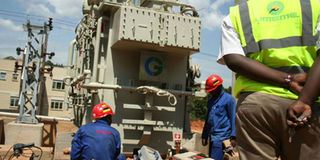Energy demand increases as Uganda faces load shedding

Engineers fix a power generator. Some areas are already experiencing abrupt power blackouts. File Photo.
What you need to know:
Several areas on the main grid which consume 97 per cent of electricity produced continue to experience power blackouts.
Panic gripped the country between December 3 and 6, when two of the five turbines of the newly-constructed 250 Megawatts (MW) Bujagali Hydropower Power Dam shut down due to a technical fault.
Places in and out of the central business district started experiencing loadshedding for long hours and the majority power distributor Umeme, revitalised its call to government to switch to thermal generation plants as the alternative.
One turbine reportedly produces a total of 50MWs but critics have maintained that the dam does not produce up to the installed capacity. One turbine was later restored but another broke down, and Bujagali Energy Ltd management has since remarked that the entire episode was a result of the scheduled maintenance works.
Several areas on the main grid which consume 97 per cent of electricity produced are still experiencing blackouts and according to Mr Henry Rugamba, the head of communications at Umeme, “this is a big cause for worry.”
Mr Rugamba notes that current power generation in the country is not enough while considering such periodical breakdowns in production.
Tough times ahead
“Between now and 2018, the country is headed for the tough times because current generation cannot sustain demand,” he says, adding,
With projects like Karuma (600MWs), Ayago and Agago hydro power stations in the offing, Mr Rugamba adds that as the distributor [Umeme], they raised the ‘red flag’ over the current crisis which “will affect the expanding economy.”
Against this backdrop, Umeme feels the need to switch on the thermal plants which the Electricity Regulatory Authority (ERA) suspended last year due to exorbitant costs after electricity subsidies were crapped by government.
The thermal generation plants are; Aggrekko Lugogo (50MW) Namanve (50MW) and Mutundwe (50MW).
Latest revelations show that the distributors have caused a wave of anxiety amongst Ugandans on the sustainability of the current power supply.
But state minister for Energy Simon D’juanga told this newspaper recently that the reported load shedding was temporary and should not worry Ugandans.
“I am not saying supply is enough but at least it can take us up to the commissioning of projects like Karuma,” he said.
In the late 1990s, government controversially unbundled the monopoly state-run Uganda Electricity Board (UEB) to create efficiency in the electricity sector, which critics say has not been realised.
The unbundling led to enactment of a new Electricity Act of 1999 and the birth of Uganda Electricity Generation Company Limited (UEGCL), Uganda Electricity Transmission Company Limited (UETCL) and Uganda Electricity Distribution Company Limited (UEDCL).
Electricity woes
The country’s electricity woes have been pinned on Umeme and a recent study by a Parliamentary Ad Hoc Committee on Energy recommended the termination of Umeme contract, a process which has since been mixed up in politics and “bribery allegations.”
Mr Dickens Kamugisa, of Africa Institute for Energy Governance [Afiego] holds the view that “If Umeme has failed efficiency tests with the current level of power supply, Ugandans should not expect them to do any better when the much-anticipated Karuma comes on board.”
Low access to electricity
The estimated population with access to electricity stands at 12 per cent accessing grid-based electricity, a two per cent increase from 10 per cent in 2005/06.
Mr Kamugisha notes the company has failed to increase electricity access; reaps heavily from inflating customer electricity bills, among others, and the issue of cancelling their contracts being mulled by some Members of Parliament is an “impossibility.”
In an interview, UETCL’s head of communications Kenneth Otim explained that current power generations stands at 516MWs from all the producers, and Umeme buys the bulk.
“We are aware the economy is growing and demand increases everyday but that does not call for switching on thermal plants. They are very expensive, especially when there is no subsidy,” Mr Otim said, adding, “Bujagali recently got a problem but we couldn’t turn to thermal because it was on short notice.”
Thermal power costs Shs779.5 a unit compared with Shs268.8 for hydropower.
Growing demand
According to UETCL-the-in-charge of transmission and selling bulk, projected demand has shot up from 470MWs recorded early this year to 494MWs at peak hours (between 8-10pm). Supply has increased from 504.2MWs to 516MWs.
Mr Otim added, “These figures are accurate because we are always monitoring from our substations.”
Umeme concurred with the aggregate and supply figures but stressed the need for more supply “to prepare for a situation when demand will outstrip supply.”
Some industry players, say some Umeme’s managers had invested in the same thermal plant before they were suspended so they want to recoup their previous investments, a claim Mr Rugamba denied.



